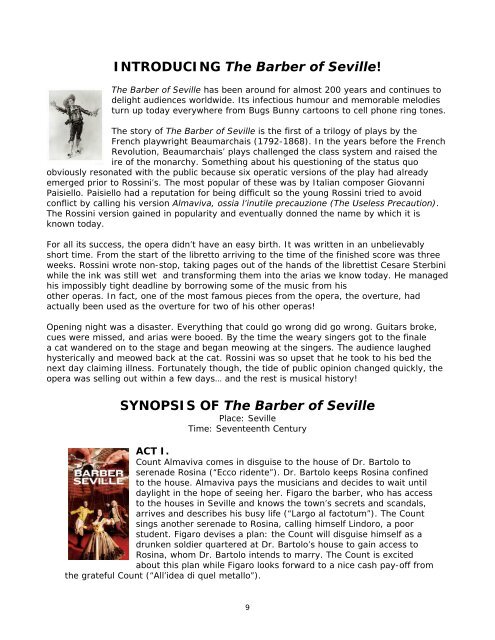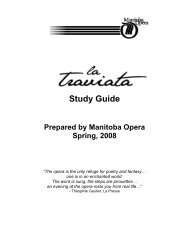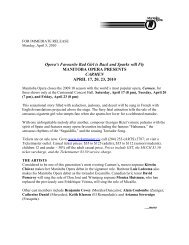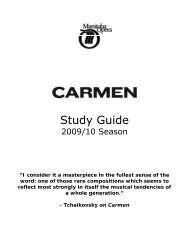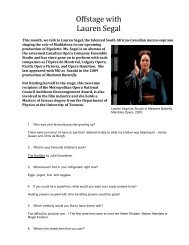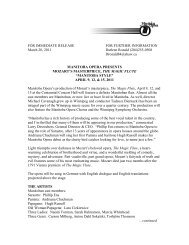The Barber of Seville Study Guide - Manitoba Opera
The Barber of Seville Study Guide - Manitoba Opera
The Barber of Seville Study Guide - Manitoba Opera
You also want an ePaper? Increase the reach of your titles
YUMPU automatically turns print PDFs into web optimized ePapers that Google loves.
INTRODUCING <strong>The</strong> <strong>Barber</strong> <strong>of</strong> <strong>Seville</strong>!<br />
<strong>The</strong> <strong>Barber</strong> <strong>of</strong> <strong>Seville</strong> has been around for almost 200 years and continues to<br />
delight audiences worldwide. Its infectious humour and memorable melodies<br />
turn up today everywhere from Bugs Bunny cartoons to cell phone ring tones.<br />
<strong>The</strong> story <strong>of</strong> <strong>The</strong> <strong>Barber</strong> <strong>of</strong> <strong>Seville</strong> is the first <strong>of</strong> a trilogy <strong>of</strong> plays by the<br />
French playwright Beaumarchais (1792-1868). In the years before the French<br />
Revolution, Beaumarchais’ plays challenged the class system and raised the<br />
ire <strong>of</strong> the monarchy. Something about his questioning <strong>of</strong> the status quo<br />
obviously resonated with the public because six operatic versions <strong>of</strong> the play had already<br />
emerged prior to Rossini’s. <strong>The</strong> most popular <strong>of</strong> these was by Italian composer Giovanni<br />
Paisiello. Paisiello had a reputation for being difficult so the young Rossini tried to avoid<br />
conflict by calling his version Almaviva, ossia l’inutile precauzione (<strong>The</strong> Useless Precaution).<br />
<strong>The</strong> Rossini version gained in popularity and eventually donned the name by which it is<br />
known today.<br />
For all its success, the opera didn’t have an easy birth. It was written in an unbelievably<br />
short time. From the start <strong>of</strong> the libretto arriving to the time <strong>of</strong> the finished score was three<br />
weeks. Rossini wrote non-stop, taking pages out <strong>of</strong> the hands <strong>of</strong> the librettist Cesare Sterbini<br />
while the ink was still wet and transforming them into the arias we know today. He managed<br />
his impossibly tight deadline by borrowing some <strong>of</strong> the music from his<br />
other operas. In fact, one <strong>of</strong> the most famous pieces from the opera, the overture, had<br />
actually been used as the overture for two <strong>of</strong> his other operas!<br />
Opening night was a disaster. Everything that could go wrong did go wrong. Guitars broke,<br />
cues were missed, and arias were booed. By the time the weary singers got to the finale<br />
a cat wandered on to the stage and began meowing at the singers. <strong>The</strong> audience laughed<br />
hysterically and meowed back at the cat. Rossini was so upset that he took to his bed the<br />
next day claiming illness. Fortunately though, the tide <strong>of</strong> public opinion changed quickly, the<br />
opera was selling out within a few days… and the rest is musical history!<br />
SYNOPSIS OF <strong>The</strong> <strong>Barber</strong> <strong>of</strong> <strong>Seville</strong><br />
Place: <strong>Seville</strong><br />
Time: Seventeenth Century<br />
ACT I.<br />
Count Almaviva comes in disguise to the house <strong>of</strong> Dr. Bartolo to<br />
serenade Rosina (“Ecco ridente”). Dr. Bartolo keeps Rosina confined<br />
to the house. Almaviva pays the musicians and decides to wait until<br />
daylight in the hope <strong>of</strong> seeing her. Figaro the barber, who has access<br />
to the houses in <strong>Seville</strong> and knows the town’s secrets and scandals,<br />
arrives and describes his busy life (“Largo al factotum”). <strong>The</strong> Count<br />
sings another serenade to Rosina, calling himself Lindoro, a poor<br />
student. Figaro devises a plan: the Count will disguise himself as a<br />
drunken soldier quartered at Dr. Bartolo’s house to gain access to<br />
Rosina, whom Dr. Bartolo intends to marry. <strong>The</strong> Count is excited<br />
about this plan while Figaro looks forward to a nice cash pay-<strong>of</strong>f from<br />
the grateful Count (“All’idea di quel<br />
metallo”).<br />
9


